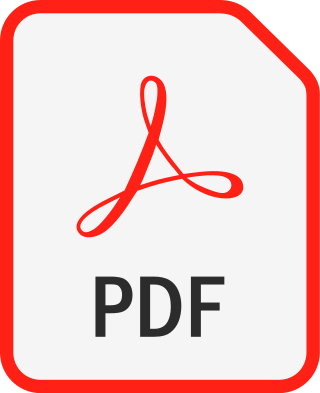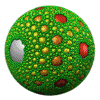Filtration is a physical process that separates solid matter and fluid from a mixture.

Portable Document Format (PDF), standardized as ISO 32000, is a file format developed by Adobe in 1992 to present documents, including text formatting and images, in a manner independent of application software, hardware, and operating systems. Based on the PostScript language, each PDF file encapsulates a complete description of a fixed-layout flat document, including the text, fonts, vector graphics, raster images and other information needed to display it. PDF has its roots in "The Camelot Project" initiated by Adobe co-founder John Warnock in 1991. PDF was standardized as ISO 32000 in 2008. The last edition as ISO 32000-2:2020 was published in December 2020.

Portable Network Graphics is a raster-graphics file format that supports lossless data compression. PNG was developed as an improved, non-patented replacement for Graphics Interchange Format (GIF)—unofficially, the initials PNG stood for the recursive acronym "PNG's not GIF".
Bit blit is a data operation commonly used in computer graphics in which several bitmaps are combined into one using a boolean function.
Vector most often refers to:
Reflection or reflexion may refer to:
Any change in a computing system, such as a new feature or new component, is transparent if the system after change adheres to previous external interface as much as possible while changing its internal behaviour. The purpose is to shield from change all systems on the other end of the interface. Confusingly, the term refers to overall invisibility of the component, it does not refer to visibility of component's internals. The term transparent is widely used in computing marketing in substitution of the term invisible, since the term invisible has a bad connotation while the term transparent has a good connotation. The vast majority of the times, the term transparent is used in a misleading way to refer to the actual invisibility of a computing process, which is also described by the term opaque, especially with regards to data structures. Because of this misleading and counter-intuitive definition, modern computer literature tends to prefer use of "agnostic" over "transparent".
As an ethic that spans science, engineering, business, and the humanities, transparency is operating in such a way that it is easy for others to see what actions are performed. Transparency implies openness, communication, and accountability.

Transparency in computer graphics is possible in a number of file formats. The term "transparency" is used in various ways by different people, but at its simplest there is "full transparency" i.e. something that is completely invisible. Only part of a graphic should be fully transparent, or there would be nothing to see. More complex is "partial transparency" or "translucency" where the effect is achieved that a graphic is partially transparent in the same way as colored glass. Since ultimately a printed page or computer or television screen can only be one color at a point, partial transparency is always simulated at some level by mixing colors. There are many different ways to mix colors, so in some cases transparency is ambiguous.
Open or OPEN may refer to:
Strip or Stripping may refer to:

Corel Photo-Paint is a raster graphics editor developed and marketed by Corel since 1992. Corel markets the software for Windows and Mac OS operating systems, previously having marketed versions for Linux. Its primary market competitor is Adobe Photoshop.
Digital usually refers to something using discrete digits, often binary digits.
An image file format is a file format for a digital image. There are many formats that can be used, such as JPEG, PNG, and GIF. Most formats up until 2022 were for storing 2D images, not 3D ones. The data stored in an image file format may be compressed or uncompressed. If the data is compressed, it may be done so using lossy compression or lossless compression. For graphic design applications, vector formats are often used. Some image file formats support transparency.
Real-time, realtime, or real time may refer to:
POV most commonly refers to:

3D computer graphics, sometimes called CGI, 3-D-CGI or three-dimensional computer graphics, are graphics that use a three-dimensional representation of geometric data that is stored in the computer for the purposes of performing calculations and rendering digital images, usually 2D images but sometimes 3D images. The resulting images may be stored for viewing later or displayed in real time.
The various versions of Microsoft's desktop operating system, Windows, have received various criticisms since Microsoft's inception.
Vision, Visions, or The Vision may refer to:
3D, 3-D or 3d usually means three-dimensional or three dimensions and may refer to:
This page is based on this
Wikipedia article Text is available under the
CC BY-SA 4.0 license; additional terms may apply.
Images, videos and audio are available under their respective licenses.



